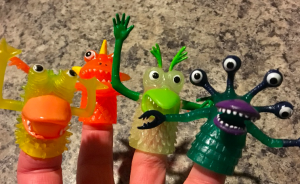From left: Twiggus, Flerjoob, Snorgustuflox and Zmoojius
Number 37 in the Cryptids Large and Small Series of Monster Care Guides by Dr. Skeezix Fremulon, World-Renowned Monstrologist
Welcome to the Wonderful World of Monster Care!
In order to keep your baby monsters healthy and happy during their crucial early months, Dr. Skeezix Fremulon has formulated this short-form guide to baby monster care based on his original three-volume classic guide to a monster’s first year. We at Téras Publishing have provided Dr. Fremulon with key details about your particular monsters so that we may provide you with this customized guide.
First, Meet Your Monsters
All four of your monsters are crepuscular fneedids, and each first emerged from its hanging cave pod at twilight during a January full moon. As you know, crepuscular monsters prefer to dine at twilight and absolutely avoid noshing during the noon or midnight hours. Because they are young, they need more sleep than adult monsters. They prefer to rest suspended upside-down like bats, but they are versatile beings and can adapt to resting in any position given practice.
Being flabjescent (finger-dwelling) monsters, they sleep with their eyes open so that they can always be aware of micromovements that might require them to rearrange their eyes, claws, antennae or fingers. Do not be alarmed if you awake to find them staring at you. They may actually be sleeping. If they are awake, you are likely to find that they are simply admiring your good looks.
Monster #1: Twiggus
Twiggus is a Jaundiced Pricklebelly. A gentle, jovial soul, her favorite foods are gooseberries and Triscuits. Her gelatinous eye pockets are light-sensitive and they act as night-vision goggles that allow her to see in perfect darkness. Her antennae are ticklish, so be careful that when you flex them, you do so delicately. Twiggus likes nomming lightly on fingertips and rolling in cotton balls. Her favorite performer is Charles Mingus.
Likes: Ginger-lemon tea, being read to during late-morning snack time, doing needlepoint, engaging in philosophical discourse
Dislikes: Chervil, mangoes, Hanna-Barbera cartoons, the letter M
Monster #2: Flerjoob
Flerjoob is a Tangerine Zogulanthropus. Anxious and easily startled, he needs frequently soothing. Though he does not own an automobile, he is always worried that he has misplaced his car keys. Has a tendency to shriek quietly when startled, and he startles easily. His shrieks are barely audible, but they rattle Snorgustuflox, so they are best avoided. When he is nervous, he finds tapioca pudding and golden raisins very comforting.
Likes: Having his teeth counted, being told that he’s a good boy, doing jigsaw puzzles featuring photos of rubber ducks, sharpening crayons
Dislikes: Loud noises, strobe lights, polyester blends, bar soap
Monster #3: Snorgustuflox
Snorgustuflox is a Celery Queezix. Singularly lacking in self-awareness, Snorgustuflox thinks he is easy-going and friendly because he waves at everyone all the time, but his gruff barking voice and aggressive manner often put people off. He is desperate for friendship and will wiggle his ferny antennae with glee when having a conversation with a new friend, but his direct questioning and habit of interrupting may be considered rude. He reacts badly to time-outs and benefits from a more relaxed approach. Gentle reminders and pleasant distractions when he becomes overbearing work best.
Likes: Cilantro-based herb blends, under-ripe bananas, hang gliding, luna moths
Dislikes: Fox News, cough syrup, backgammon, socks
Monster #4: Zmoojius
Zmoojius is a Flangified Multiocularian. A practical joker, she likes bending her eyestalks around corners, sticking them into things and commenting on what she sees. As a rare aubergine-snooted variety, she tends toward self-importance, but she has a good heart and is more likely to pick flowers for you with her clasping flangicles than to pinch you with them. A romantic monster, she enjoys eating Valentine heart candies and listening to soft-rock ballads while staring up at the moon.
Likes: Rom-coms, cornstarch, the way people’s eyes scrunch up when they smile, sphagnum moss
Dislikes: Cider vinegar, dust mites, egg salad, stand-up comedy specials
In Conclusion: Relax and Enjoy Your New Friends
It is normal for baby monsters to sleep for up to 23 hours a day and to cluster together in strange combinations. They play a mini-monster variant of Twister that requires no mat or spinner, so don’t be surprised if you find them gathering and piling up in unexpected ways. They are quite fond of bubble baths and underwater toe rides. They play hide and seek whenever possible, and particularly enjoy hiding in medicine cabinets, refrigerators, underwear drawers and glove compartments.
While your monsters have strong opinions, they are gentle souls at heart. You will find that as long as they receive frequent smiles, kind words and good snacks, they are quite easy to live with and will provide years of enjoyable companionship.




